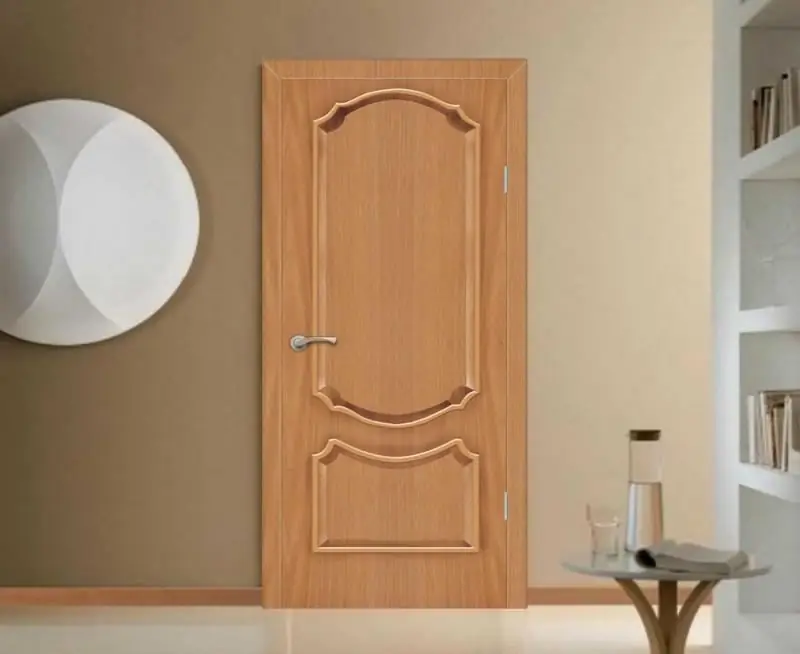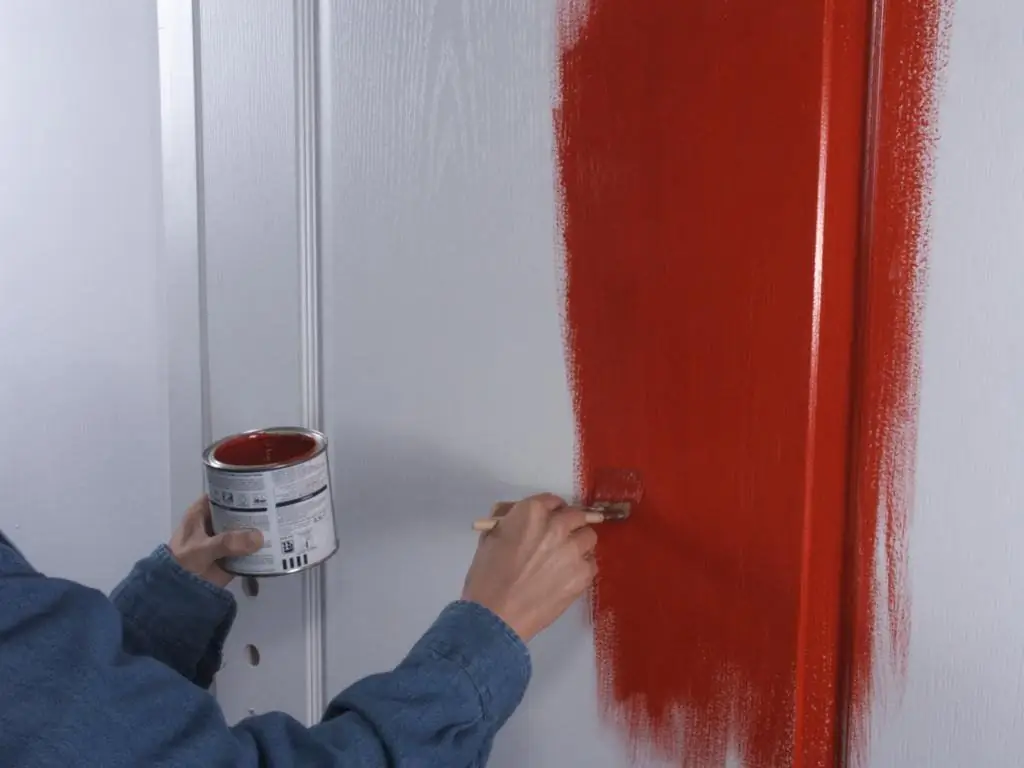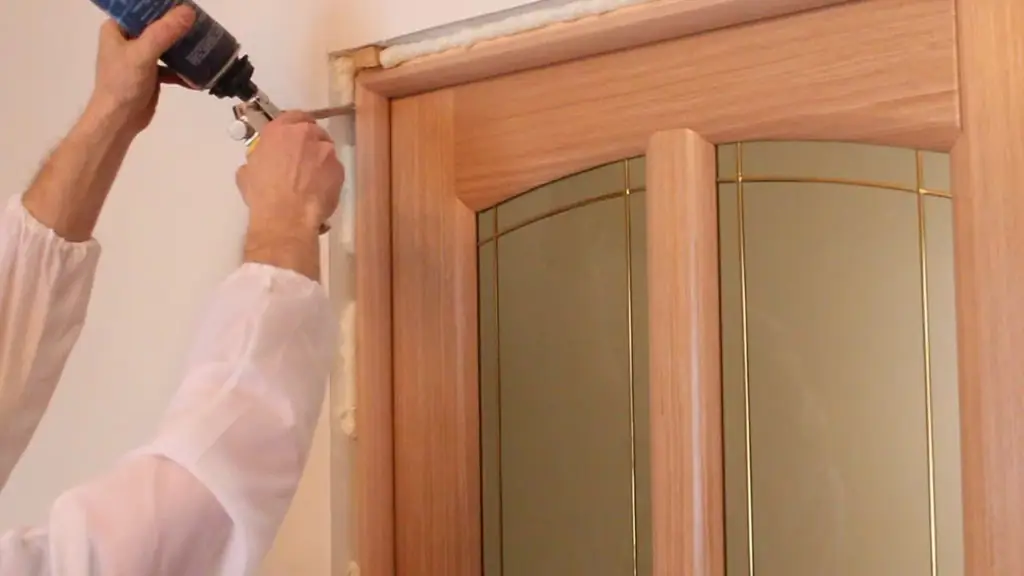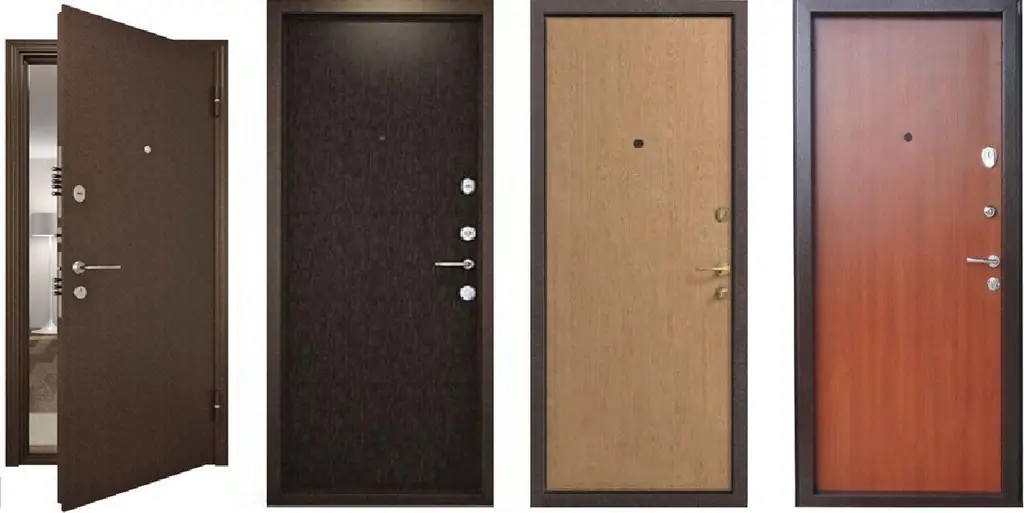
Table of contents:
- Author Bailey Albertson [email protected].
- Public 2024-01-17 22:26.
- Last modified 2025-01-23 12:41.
How to restore wooden doors with your own hands

Doors made of solid wood look solid and are distinguished by their durability, but in order to preserve their appearance and quality, it is important to carry out restoration. For this purpose, there are different methods and special materials are used, but it is always possible to carry out repairs with your own hands.
Content
-
1 When it is necessary to restore wooden doors
1.1 Photo gallery: options for wooden doors
-
2 Do-it-yourself wooden door restoration
- 2.1 Tools and materials for restoration
-
2.2 Restoration for scratches on solid wood doors
2.2.1 Video: Removing scratches on a laminated door
-
2.3 How to remove old varnish
1 Video: Removing paint from a door with a building hair dryer
-
2.4 Removing stains and dirt from a wooden door
2.4.1 Video: Using the sander
-
2.5 Complete door upgrade
2.5.1 Video: DIY wood brushing
-
3 Features of painting wooden doors
3.1 Video: painting a solid wood door
-
4 How to sheathe wooden doors
4.1 Video: how to sheathe doors with dermantin
When restoration of wooden doors is necessary
The restoration of wooden doors is a process aimed at repairing the structure, that is, restoring the appearance of the leaf, the functionality of the door and the quality of the coating. Such an event is easy to carry out on your own, avoiding the cost of the services of a professional craftsman and returning a beautiful appearance and ease of use to the wooden product.

Any kind of wooden doors can be restored
The need for restoration can be determined by external examination of the door structure. This method is relevant for both interior and entrance paintings. The most common reasons for restoration are as follows:
- scratches, chips, abrasions of the paintwork on the door surface;
- cracks between the elements of the canvas, for example, in the area of the panels;
- stubborn stains, darkening of the wood surface;
- damage to decorative elements of the door, for example, glass inserts;
- damaged skin that has lost its appearance.

Complex door decor requires special care
If the canvas or platbands are decorated with carvings that require restoration, then it is best to entrust this work to a professional craftsman. This is due to the fact that it is possible to preserve a skillful carving or a complex pattern only with the help of special tools and working methods. Simple and straight doors, restored by your own hands, are easy to make spectacular if you brush them. This process is suitable for the restoration of canvases that do not require preservation of the original appearance.
Photo gallery: options for wooden doors
-

Sauna wooden door - The bath door may need restoration after many years of use.
-

Wooden front door - Wooden entrance doors most often need repairs
-

Carved canvas from solid wood - Carved canvases require professional restoration
-

Double leaf wooden door - Double-leaf doors are time-consuming to repair
-

Solid wood entrance door -
Not only the canvas is restored, but also the box and platbands
-

Double-leaf wide doors in the house - Glass doors require careful handling
-

Dark wooden door - During restoration it is important to preserve the design style of the structure
DIY wooden door restoration
Self-repair and restoration of the appearance of the structure involves the preparation of certain tools, compliance with the rules of work. It should be borne in mind that large-scale restoration, for example, full painting of the door, requires removing the canvas from the hinges. If it is necessary to slightly improve the appearance of the product, for example, to remove stubborn stains, then there is no need to remove the structure. In any case, be sure to take into account the instructions for use of coloring agents, if any are used in the work.

It is more convenient to restore doors removed from hinges
Before work, you need to prepare the necessary materials and tools, as well as a place of sufficient area for placing the canvas. This will avoid additional damage to the structure and promptly carry out repairs.
Tools and materials for restoration
To restore a natural wood door, you will need simple materials and tools that can be purchased at a home improvement store. The work uses the following elements, selected depending on the existing problems:
- sharp knife, hammer, screwdrivers, pliers;
- coarse to fine sandpaper, sander;
- putty knife and acrylic putty for wood;
- paint brushes of different widths;
- spray gun and varnish for wood;
- furniture stapler and staples;
- liquid for removing varnish from wood.

Sandpaper and a sander are required to level the surface of the door leaf
All cutting tools must be sharp, and various grit sandpaper is required to remove bumps, old varnish and paint. This allows the door to be prepared for renovation and also makes the restoration more efficient.
Restoration for scratches on solid wood doors
The most common reason for restoring wooden doors is surface scratches. If such damage is invisible at first glance, then it can be hidden without extensive work. To do this, you need to choose a furniture marker or corrector to match the color of the door and treat the scratches with this tool. This method is very effective and does not require a lot of time and effort for repairs.

Small scratches can be easily hidden with furniture wax to match the surface color
Deep scratches require more serious intervention than minor damage. For work, it is better to remove the canvas from the hinges, but you can also carry out the restoration in place. The main stages of repair involve the following actions:
- By examining the surface, the location of the scratches should be determined.
- The place of damage is degreased with alcohol-containing compounds, applying a small amount to the cloth and wiping the cloth.
- Furniture wax is gently rubbed into the scratches. If a marker is used, then it is carried out at the site of damage, and then the surface is treated with transparent wax.
- Remove excess funds with a slightly damp cloth.
- Thus, they process all the necessary places on the canvas, you can mask scratches on the box, platbands and other wooden parts.
- To eliminate deep scratches on the canvas, you need to apply a small amount of putty, level it, wait for it to dry and cover the damaged area with wax or varnish.

Acrylic colored putty is suitable for deep scratches
For solid wood doors, use products designed for wood, laminated or veneered surfaces. This will ensure the high quality of the restoration work, the durability of the result and the optimal combination of materials.
Video: removing scratches on a laminated door
How to remove old varnish
Wooden doors are varnished or painted to protect them from moisture and dirt. As a result of many years of operation, this layer cracks, giving the canvas an unpresentable look. In this case, restoration of the door is necessary to restore the appearance of the product. Before such a process, you need to remove the old varnish or paint. The complex of works includes such stages as:
- Removing the blade from the hinges and placing it on a workbench or other flat and level surface.
- Brushing on wood varnish remover, waiting for the agent to react according to the instructions in the instructions.
- Remove the varnish layer with a spatula and then with fine-grained emery paper.
- Elimination of paint residues with medium-grained sandpaper and subsequent sanding of the surface of the canvas.
- Removing paint with a building hair dryer, by heating surface areas and scraping off swollen layers.

The varnish is removed in stages and carefully, without damaging the wood structure
Solid wood structures can be covered with a stain that is deeply absorbed into the wood. It will not be possible to completely remove such a dye to obtain a natural wood color. In this case, you need to remove the old varnish and apply a new one over the stain.
Video: removing paint from a door with a building hairdryer
Removing stains and dirt from a wooden door
Unpainted wood surfaces are susceptible to dirt and dust, resulting in greasy and dark stains on the surface. You can eliminate such defects by sanding the canvas. To do this, you need a sander with fine-grained sandpaper and a soft brush to remove dust. The process involves the following steps:
- Removing the door from the hinges and placing it on the workbench.
- Processing of all planes with a grinder.
- Hand-sanding complex bends with sandpaper.
- Removing dust with a soft brush.

The sander is more convenient and efficient to use than sandpaper
Small stains on surfaces covered with varnish or paint can be easily removed with furniture cleaners. They are applied to a soft napkin and wiped off the surface. Hard sponges are not used, as they can damage the wooden door.
Video: application of the grinder
Complete door renovation
Old doors, painted or varnished, often have high durability, but require renewal of the coating. To do this, you can simply remove the paint, sand the surface and apply a new coat of paint and varnish composition. An effective solution is the brushing method, which is combined with staining. In this case, the canvas is completely renewed, takes on a new look. To do this, carry out the following actions:
- Removing old paint and creating an embossed structure using a metal brush that is fixed to a drill.
- Manual surface grinding with fine-grained sandpaper.
- Application of the component in the area between the panels.
- Brushing flat parts of the door.

As a result of brushing, a relief structure of wood is obtained
Before work, be sure to remove the lock and door handle, which is necessary for any painting or removing varnish from a wooden surface. If the blade is being removed to remove scratches, it is also best to remove the lock and handle.
Video: do-it-yourself wood brushing
Features of painting wooden doors
For dyeing wood, special means are used that not only tint the surface, but also protect it from mechanical, chemical and other influences that can negatively affect the quality of the product. Processing can be done with stain, paint or varnish. Often the doors are covered with both stain and varnish, since the first component gives color, and the second is needed to protect the surface.

Brush painting is optimal for small areas
When painting, tools such as a brush or spray gun are used. In small areas, it is appropriate to use a brush or a piece of foam rubber, and a flat large surface is best treated with a spray gun for even distribution of the composition. The main stages of painting are expressed in the following actions:
- Preparation, dilution of the product according to the instructions.
- Pouring paint or varnish into a special container of the spray gun.
- Test spraying of the composition onto a test plate.
- Application of paint to the product by short sprays at a distance of about 30 - 40 cm from the surface.
- Application of the second layer, after the first has dried.
Video: painting solid wood doors
How to sheathe wooden doors
A quick method to completely renovate old solid wood doors is to cover the door leaf with different materials. In this case, prepared sheets of MDF, laminate or other structures are attached to both sides of the door. This allows you to quickly restore old doors without spending a lot of time and effort on correcting the coating.

The color palette of MDF or laminate is extensive, which allows you to match sheets to match the overall interior
For cladding, MDF sheets or laminated chipboard can be used. The thickness of the panels should be up to 0.8 cm. The technology for attaching them to a wooden door involves removing the canvas from the hinges, removing the fittings. On the panels with which the door will be framed, holes should be cut for the handle and lock. For work, you will need liquid nails and a gun to apply this tool. Further, the following actions are carried out:
- Doors are cleaned of dirt and old paint, and the surface is polished.
- Liquid nails are applied in strips along the perimeter and across the door.
- A chipboard or MDF panel is applied and pressed against the door, placed under the load for better fixation.
- After one side has dried, the other part of the door is sheathed according to the same principle.
- A lock, handle, peephole, hinges are installed on the dried structure.
- Chipboard or MDF panels can be painted with wood paint or covered with laminated film.
- To decorate with a film, you need to lay it out on a canvas and, carefully smoothing it, process it with an iron.

Covering the door with laminate will not only make its appearance more attractive, but also update the overall design of the room
You can update old doors by plating them with dermantine, which is important for entrance structures. Such material is presented in a wide variety of shades, and to work with it you will need foam rubber up to 5 cm thick, small carnations, scissors and a tape measure. To finish the door, you need to carry out the following activities:
- A piece of the size of the door leaf should be cut out of a sheet of foam rubber, and a piece is made of dermantine, the size of which is 5-7 cm larger than the perimeter of the door.
- Foam rubber is laid exactly on the door, covered with dermantine on top, one of the edges of the material is tucked under the foam rubber.
- The turned-up edge is fixed at the corner with studs, distributing the fasteners every 10 cm.
- Thus, each side is processed, controlling the evenness.
- In the middle of the canvas, carnations are driven in at an equal distance from each other.
- In the area of the lock, you need to make a hole in the dermantine and foam rubber, and then install the mechanism.
Video: how to sheathe doors with dermantin
The restoration is aimed at restoring the appearance of wooden doors and improving their performance. Many methods allow you to independently repair the structure, extending its service life. When implementing any method, the technology of using the means and materials is observed.
Recommended:
MDF Doors: Entrance And Interior Doors, Their Varieties With A Description And Characteristics, Advantages And Disadvantages, As Well As Installation And Operation Features

Doors from MDF: features, characteristics, varieties. Making and installing MDF doors with your own hands. Door restoration. Reviews, photos, videos
Painting Wooden Doors: Which Paint Is Better To Choose, As Well As How To Properly Varnish The Surface

How to prepare a door for painting and which product to choose. Tools and materials for painting wooden doors. How to paint yourself
Do-it-yourself Repair Of Interior Doors, As Well As Their Adjustment And Restoration

How to repair an interior door and what materials are needed for this. How the door is dismantled and the structure restoration technology
Restoration And Renovation Of Metal Entrance Doors, Including How And How To Paint

Do-it-yourself renovation and restoration of the entrance metal door. Restoration methods and technology for their implementation. How you can refine your front doors
Do-it-yourself Restoration Of Old Interior Doors: The Main Methods And Stages Of Work, Photos And Videos

How you can restore doors with your own hands. Preparatory work. The main methods of door restoration
